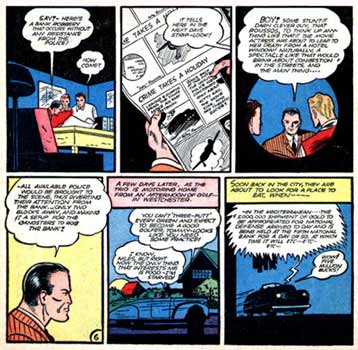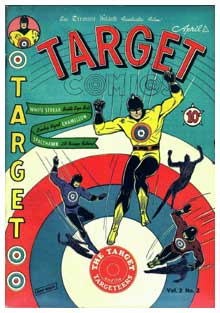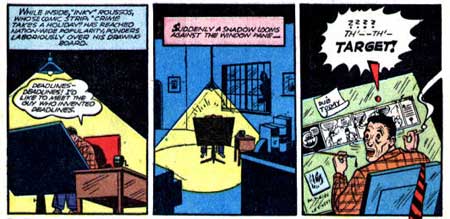'Target'.
Bob Wood was an American illustrator and artist for the Harry "A" Chesler Group during the American Golden Age of comics. He created illustrations for various pulp crime novels. As a comic artist he was co-creator of the series 'Crime Does Not Pay' (1942-1955), alongside Charles Biro. Wood additionally drew a newspaper comic, 'Goodbyeland' (1937-1938). Unfortunately Wood's life ended in tragedy. In 1958 he was convicted for manslaughter on his girlfriend. In 1966 he himself died in a car accident.
Early life
Bob Wood was born in 1917 as Robert Louis Silva in New Bedford, Massachusetts. His father was a physician of Portuguese descent who worked at an insurance company. In 1918 he was charged with forgery and speculation, which prompted the family to move to Arlington in the same state, where he set up a store affiliated with the United Drug Company. In 1925 father Silva was arrested again, this time for embezzling money under false pretenses from the United Drug Company, which led to a second conviction for larceny. After serving jail time, he was released in 1929. Unfortunately Silva committed suicide in 1931. Wood's brothers, Dick Wood and Dave Wood, were both active comic writers in their own right.
Early comics
After completing the 11th grade of high school, Bob Wood joined the Harry "A" Chesler Group in 1937, alongside Jack Cole, Charles Biro, Paul Gustavson and Mort Meskin. Together they contributed illustrations work to companies like Lev Gleason (Silver Streak Comics, Daredevil Comics, Boy Comics), MLJ (Pep Comics, Top Notch) and Novelty Press (Target Comics). The same year Wood also contributed drawings to The Funny Pages, a comic book magazine. Wood also worked on a daily newspaper comic called 'Goodbyeland' in 1937-38.
Cover illustrations for Silver Streak Comics and Target Comics.
Crime Does Not Pay
Together with his Chesler colleague Charles Biro, he also edited some Lev Gleason titles, such as their signature work 'Crime Does Not Pay' (July 1942-July 1955). This was the first comic book series based on real-life crime stories. All comics drew inspiration from famous and less famous but always sensational crimes and arrests, most involving gangsters, bank robbers, outlaws and murderers. The tone was adult, with graphic depictions of violence and direct allusions to sex and drug abuse. Yet for a long while they could pass the censors, since every tale concluded that crime either leads to moral decay, death, prison time or execution. 'Crime Does Not Pay' introduced a mascot from issue #24 on, Mr. Crime, who served as the host and narrator of every issue and story. Between April 1948 and August 1955 a spin-off magazine, 'Crime and Punishment', was launched.
Slowly but surely 'Crime Does Not Pay' became a tremendous best-seller, reaching over one million readers by 1948. It inspired many copycat comics, incuding 'Headline Comics' and 'Real Clue' (Hillman Periodicals, 1947), 'Official True Crime Cases' (Marvel, 1947), 'Gang Busters' (DC, 1947) and 'Crimes By Women' (Fox, 1948). The idea of a mascot hosting each issue was later copied by E.C. Comics and their horror and mystery tites. Yet by the mid-1950s moral guardians, concerned parents, teachers and priests started campaigning against these depraved comics which corrupted the youth. This effectively ended the series by July 1955.
Final years, murder case and death
The cancellation of EC Comics in 1955 was bad news for Wood, who'd always been an unstable person. He was a long-time alcohol and gambling addict. Now unable to earn a living with cartooning, his problems only worsened. In 1958 his second marriage ended in divorce. The same year, on 27 August 1958, he murdered his girlfriend Violette Phillips in a motel during a drunken fight. Wood planned to commit suicide and took a taxi to flee the murder scene. Drunk, he stupidly told the driver what happened, who instantly turned him in to the police. On 2 December 1958 Wood was sentenced to three years in prison for manslaughter. The irony that the cartoonist of 'Crime Does Not Pay' learned the same lesson did not go unnoticed. On 8 August 1961, having served two years and eight months of his sentence, Wood was paroled. Yet within half a year, on 19 February 1962, he was jailed again for parole violation. By the time he was permanently released, on 3 July 1963, the disgraced cartoonist was forced to work as a dishwasher at the Melody Diner in Clifton, New Jersey, because no publisher wanted to be associated with him again. On 7 November 1966 Wood died in a traffic accident, at age 49.
Bob Wood, drawing George Roussos in Target Comics.





